
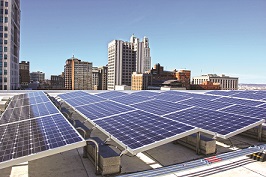
With the increasing value of efficiency, it becomes incumbent upon the corporate real estate executive — and particularly the site selection, energy and portfolio management service providers and consultants — to understand how energy efficiency and renewable energy investment fits within a broader corporate strategy context. Indeed, the real estate professionals and service providers who do not learn how to value efficiency more comprehensively might do a disservice to their clients through poorly structuring and inaccurately valuing the investment, reducing profitability and increasing risk.
Rocky Mountain Institute’s recently released report How to Calculate and Present Deep Retrofit Value for Owner-Occupants (Deep Retrofit Value practice guide) shows how to tap into that value. The guide helps site selection, corporate real estate and other professionals move forward with and achieve their goals to build business value through highly efficient buildings.
RMI's Retrofit Value Model
Deep Retrofit Value is based on the four pieces of RMI’s Retrofit Value Model (see figure). That model shows, at a high level, the evaluation process business leaders should make of deep retrofit investments.
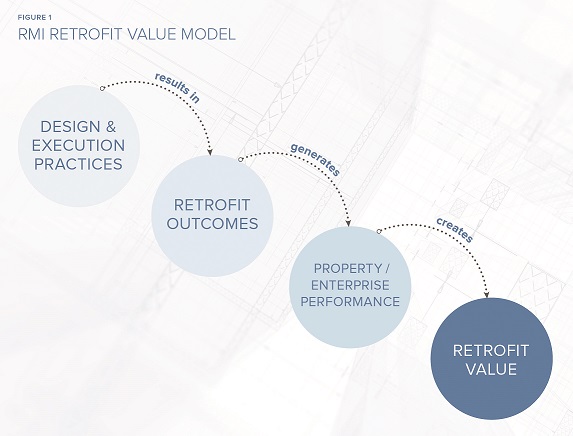 For example, consider the installation of an updated air ventilation system (a design and execution practice). This system uses less energy, improves air circulation and creates better indoor air quality (direct retrofit outcomes). Because air circulation is improved, employees are more comfortable; because air quality is better, employees get sick less often (indirect retrofit outcomes). The ventilation system provides benefits with direct implications for an organization’s bottom line: greater comfort and fewer sick days create a context whereby employees are more engaged and productive — meaning more work is accomplished and more innovations are fostered — as well as reduces the costs associated with absenteeism and the recruitment of new employees to replace those who leave the organization (property/enterprise performance). And that improvement in property/enterprise performance has quantifiable value that can be directly tied back to the deep energy retrofit (retrofit value).
For example, consider the installation of an updated air ventilation system (a design and execution practice). This system uses less energy, improves air circulation and creates better indoor air quality (direct retrofit outcomes). Because air circulation is improved, employees are more comfortable; because air quality is better, employees get sick less often (indirect retrofit outcomes). The ventilation system provides benefits with direct implications for an organization’s bottom line: greater comfort and fewer sick days create a context whereby employees are more engaged and productive — meaning more work is accomplished and more innovations are fostered — as well as reduces the costs associated with absenteeism and the recruitment of new employees to replace those who leave the organization (property/enterprise performance). And that improvement in property/enterprise performance has quantifiable value that can be directly tied back to the deep energy retrofit (retrofit value).
The non-energy cost aspects of Deep Retrofit Value fall into nine discrete value elements. They serve as a menu of the potential types of value a retrofit can create.
Retrofit Development Costs
Retrofit development costs are critical because they represent the initial capital investment against which future cost savings and other benefits are measured. Many retrofit projects have little cost premium if timed correctly with other capital improvement projects and if the project follows Deep Retrofit Value best practices. A very large percentage of the gross deep retrofit capital cost can be offset by the ongoing “business-as-usual” capital costs of the building. Buildings require major and minor improvements over time, whether for major capital upgrades, equipment replacement, accommodating changing employee needs or other reasons. Deep retrofits take the place of many of these costly (but standard) building interventions.
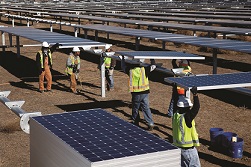
Non-Energy Property Operating Costs
Deep retrofits can reduce non-energy operating costs, which include maintenance, water, insurance and occupant churn rate. In some cases, a deep retrofit can also add more occupied space in a building through equipment downsizing, and more commonly increase occupant density to either add more occupants to the building or sublease the extra space — in both cases reducing the net property operating cost per employee-occupant. Maintenance costs are generally five to 10 percent lower in green buildings than in average buildings. Deep retrofits also have the opportunity to save 40 percent or more of total water consumption in U.S. commercial buildings. And more and more insurance companies are recognizing the benefits of green buildings and rewarding property owners with lower premiums and improved protection against loss.
Non-energy operating cost savings create value directly for the property owner by increasing net operating income, which is capitalized to create property value. Similarly, if an enterprise’s earnings are increased because energy/building costs are reduced, company value is increased.
Retrofit Risk Mitigation
Risk is one of the most important factors in any deep energy retrofit capital decision. Deep retrofits are often subject to the standard and relatively high real estate risks of a “to-be-built” project where development costs and future operating cost savings that determine return on investment (ROI) are forecast. These normally high risks can be compounded by additional risks including new products and systems, system interoperability problems, new specialized service providers, new contracts and design processes, complex financing requirements and potential energy savings underperformance from building energy simulation models.
Following Deep Retrofit Value best practices and fully presenting the risks enables risk mitigation.
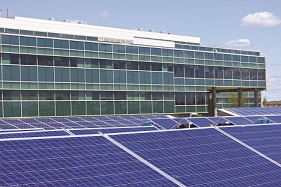 Health Costs
Health Costs
There is substantial evidence that intelligently retrofitted and operated buildings improve the health of building occupants and users, directly reducing health costs. Retrofits and operating practices can control moisture and pollutant sources, improve ventilation and access to outside air, promote access to the natural environment and lighting, address temperature control and apply ergonomic furniture. Studies show that these healthier buildings can lower incidence and severity of asthma symptoms, respiratory illness, depression, anxiety and even chronic pulmonary disease and cancer. There is also a growing level of study and recognition of the relationship between public health concerns like obesity and how buildings and communities are designed.
Such building-related health benefits create value for the occupant by lowering health costs, reducing absenteeism and presenteeism (studies have shown by 15 to 40 percent), and reducing litigation and future regulatory risk. Perhaps even more important, improved mental and physical health contributes to occupant productivity and satisfaction, which creates value through employee cost reductions.
Employee Costs
There is strong evidence that deep retrofits can reduce employee costs by lowering recruiting, retention and employee compensation costs.
Recruiting and retaining employees is costly for many businesses. This is particularly true for businesses requiring top-tier or specialized talent. For companies that are in highly competitive employee sectors, a deep retrofit and the resulting positive work environment and satisfaction can supplement other efforts to attract top talent, as well as improve retention of key staff. Studies documenting cost savings from this connection show that retention correlates to employee engagement and buy-in, and employees routinely list environmental performance as a desired characteristic.
The improvements created by deep energy retrofits reduce absenteeism and improve the quantity of work produced, reducing employee cost per unit of output — potentially reducing the number of employees required or enabling employees to produce more. Reductions in the number of employees or the salary per unit of output can reduce employee costs directly.
Promotions and Marketing Costs
The substantial expenses associated with promotions and marketing — typically in the range of 10 percent of revenues — often do not include all the time spent by non-marketing staff in promotions and marketing activities. Deep retrofits can provide the content many companies are looking for to shape their branding story, offsetting money that would otherwise be spent developing other approaches to sustainability branding. Deep retrofits can also contribute to the growing sustainability compliance requirements of many businesses and governments, becoming a minimum standard to be able to market a company’s product.
Deep retrofits contribute to the reputation and leadership of tenants and lead to increased rents, tenant retention and occupancy, as well as improved brand recognition and access to capital for the investor company.
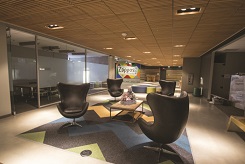
There is growing evidence that deep retrofits directly contribute to improved customer access and sales. Customers of all types — direct consumers, businesses and governments — are beginning to require demonstrated sustainability performance and leadership as part of their decision to purchase. Buildings are an important component of most companies’ production processes, so executing deep retrofits can help company products achieve higher sustainability ratings. There is also growing evidence that more healthy, productive and satisfied workers have been shown to be more engaged and innovative, increasing sales potential.
Individual consumers are also becoming more accustomed to exerting their sustainability preferences in their purchasing. If companies are looking to boost the sustainability of their product and grow sales to adapt to this change in demand, deep retrofits can provide an effective component of their product strategy. Retrofitted buildings also contribute directly to product sustainability because buildings are important factors of production, are components of an environmental footprint and contribute to overall company sustainability ratings.
Property-Derived Revenues
Deep energy retrofits can provide additional company revenues from the enhanced demand for deep retrofit properties from potential tenants in the event a company must lease some of its space or from potential buyers of the property in the event a company must sell. Other revenues can come from purchase agreements, energy services agreements, renewable energy certificates and government or utility tax credits, rebates or other subsidies.
Increased subleasing, property sales and other revenues directly translate to value by increasing enterprise revenues, which in turn increase earnings, which are translated into value by a price earning multiple that reflects the risks the market sees in the earnings.
Enterprise Risk Management/Mitigation
Deep retrofits can significantly contribute to mitigating some of the more pressing business risks facing companies today, primarily by contributing to an enterprise’s performance as measured by sustainability reputation and leadership; individual occupant health, productivity and satisfaction; and space flexibility. The historic focus on energy cost savings alone leaves out valuable contributions of deep retrofits and focuses on a low-priority issue for occupiers.
There are numerous ways to think about the value of a business enterprise. Regardless of the method, it is impossible to determine a company’s value or properly assess any financial analysis of a deep retrofit investment without an assessment of risk. The analysis of enterprise risk in a deep retrofit capital funding presentation can provide an extra layer of valuable benefits for decision makers to consider. Higher levels of energy and sustainability performance from a deep retrofit can reduce current and future regulatory risk, lower health and other employee costs, maximize space flexibility and promote the brand and reputation of the company, improving customer access and mitigating financial shocks to the company. These additional risk benefits can be quite valuable, and ignoring or not properly presenting them could lead corporate leaders to underinvest in property energy efficiency/sustainability, lowering company value and threatening future profitability.
Assessing a Deep Retrofit Project
To assess a deep retrofit project, a professional must evaluate the outcomes of a deep energy retrofit on a given value element and then address how the outcomes create business value. The goal of RMI’s Deep Retrofit Value initiative is to dramatically increase energy efficiency and sustainability investment by enabling retrofit decision makers to properly incorporate all value and risk considerations into their decision making. As with any potential profit opportunity, a company must invest and take risks to mine potential profits. In this regard, the cost involved in deep retrofit investment, including the cost of calculating deep retrofit value, is a small price to pay to potentially access a gold mine and create a clean, prosperous and secure energy future for all.

